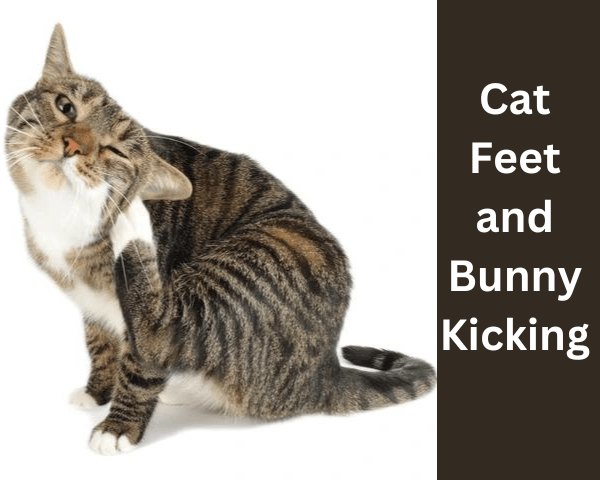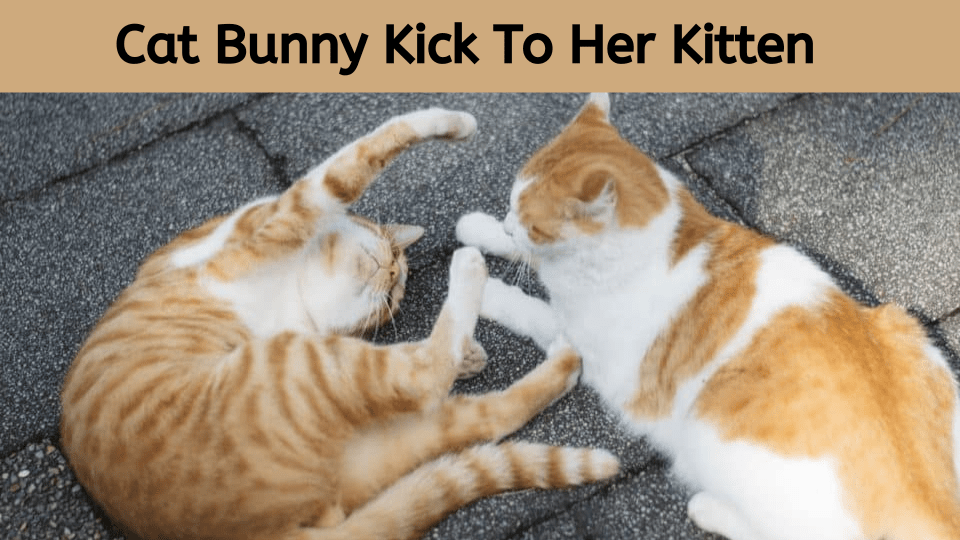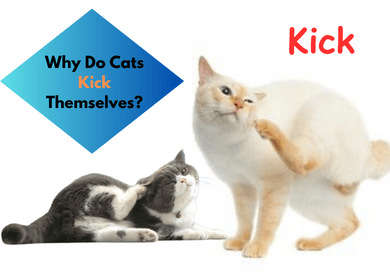Cats are known for their playful and sometimes aggressive behavior, which includes kicking themselves with their hind legs. But why do cats kick themselves?
There are a few reasons why cats engage in this behavior. One reason is that they are trying to scratch an itch they cannot reach. Another reason is that they are anxious or stressed and this is a way for them to release that energy.
Finally, they may be doing it as part of a mating ritual. In this article, we will explore the anatomy of cat feet, the different types of bunny-kicking, and the possible causes and solutions for this behavior.
Contents
Why Do Cats Kick Themselves?
There are many reasons why cats kick themselves in the face. ranging from harmless to serious. Here are some of the most common ones:
Practicing hunting skills
Cats are natural predators, and they need to hone their hunting skills regularly. Kicking themselves or their toys is a way for them to practice catching and killing their prey, using their powerful hind legs and sharp claws.
This is especially true for indoor cats, who cannot access real prey. Kicking themselves or their toys helps them satisfy their predatory urges and keep their muscles and reflexes in shape.
Releasing pent-up energy
Cats are active and energetic animals, and they need to burn off their excess energy somehow. Kicking themselves or their toys is a way for them to release that energy and have some fun.
This is especially true for young cats, who have more energy than older cats. Kicking themselves or their toys helps them relieve their boredom and stress, and prevent behavioral problems such as aggression or destructiveness.
Scratching an itch
Cats are very clean and hygienic animals, and they groom themselves regularly. However, sometimes they may have an itch that they cannot reach with their tongue or front paws.
Kicking themselves is a way for them to scratch that itch and relieve their discomfort. This is especially true for cats who have long or thick fur, or who have skin problems such as allergies or infections. Kicking themselves helps them remove dirt, debris, or parasites from their fur or skin.
Grooming themselves
Cats are very meticulous and thorough when it comes to grooming themselves. Sometimes, they may use their hind legs and claws to groom themselves, especially in hard-to-reach areas such as their ears, neck, or back.
Kicking themselves is a way for them to clean and comb their fur, and remove any mats or tangles. This is especially true for cats who have long or curly fur, or who have grooming problems such as over-grooming or under-grooming. Kicking themselves helps them maintain their coat quality and appearance.
Defending themselves
Cats are very territorial and independent animals, and they do not like to be threatened or challenged. Sometimes, they may kick themselves or other animals as a way of defending themselves or their territory, especially if they feel cornered or attacked.
Kicking themselves is a way for them to ward off or injure their opponents, using their powerful hind legs and sharp claws. This is especially true for cats who are not socialized or who have aggression problems such as fear aggression or territorial aggression. Kicking themselves helps them protect themselves and their space.
Expressing mating behavior
Cats are very reproductive and hormonal animals, and they have a strong mating drive. Sometimes, they may kick themselves or other cats as a way of expressing their mating behavior, especially if they are in heat or ready to mate.
Kicking themselves is a way for them to attract or stimulate their potential mates, using their hind legs and claws. This is especially true for cats who are not spayed or neutered, or who have mating problems such as spraying or yowling. Kicking themselves helps them fulfill their reproductive needs and desires.
Cat Feet and Bunny-Kicking
Cats have four toes on each of their hind feet, and five on each of their front feet. Their toes have retractable claws that they can use for hunting, climbing, scratching, and grooming.
Cats also have a special toe on the back of their hind legs, called the dewclaw, that helps them grip their prey or toys.
Cats use their hind legs to kick themselves or other objects in a motion called bunny-kicking.
This is because they look like a rabbit when they do it. Bunny-kicking can be a normal and healthy behavior for cats, as long as it is not excessive or harmful. There are different types of bunny-kicking, depending on the context and the intensity of the kicks.
- Playful bunny-kicking: This is when cats kick themselves or their toys lightly and gently, as a way of having fun or practicing their hunting skills. This is usually accompanied by purring, meowing, or chirping sounds, and a relaxed body posture. Playful bunny-kicking is a good way for cats to exercise and stimulate their instincts.
- Aggressive bunny-kicking: This is when cats kick themselves or other animals hard and fast, as a way of defending themselves or expressing dominance. This is usually accompanied by hissing, growling, or yowling sounds, and a tense body posture. Aggressive bunny-kicking can cause injuries or infections, especially if the claws are not trimmed or cleaned regularly.
- Affectionate bunny-kicking: This is when cats kick themselves or their owners softly and slowly, as a way of showing love or trust. This is usually accompanied by kneading, licking, or rubbing sounds, and a relaxed body posture. Affectionate bunny-kicking is a rare and special behavior that indicates a strong bond between the cat and the owner.

How to Keep Your Cat Healthy and Happy
As you can see, there are many reasons why cats kick themselves, and most of them are normal and healthy. However, some of them can be problematic or harmful, especially if they are excessive or frequent. Here are some tips and advice on how to keep your cat healthy and happy, and prevent or treat any issues related to kicking themselves:
- Provide enough stimulation and enrichment: Cats need to have a stimulating and enriching environment, where they can exercise their body and mind, and satisfy their instincts. You can provide them with toys, scratching posts, cat trees, windows, and interactive play sessions, where they can kick, chase, pounce, and explore. This will help them release their energy, practice their skills, have some fun, and reduce their need to kick themselves or other objects.
- Trim and clean their claws: Cats need to have their claws trimmed and cleaned regularly, to prevent them from growing too long or becoming infected. You can use a nail clipper or a file, and gently cut or file the tip of their claws, avoiding the quick (the pink part that contains blood vessels and nerves). You can also use a disinfectant or a wipe, and gently clean their claws, removing any dirt, debris, or bacteria. This will help them avoid injuries or infections, and keep their claws healthy and sharp.
- Check and treat their skin: Cats need to have their skin checked and treated regularly, to prevent or cure any skin problems such as allergies or infections. You can use a brush or a comb, and gently groom their fur, removing any mats, tangles, or parasites.
You can also use a shampoo or a spray, and gently wash or spray their fur, removing any dirt, debris, or allergens. You can also consult your vet, and get them tested or treated for any skin conditions or diseases. This will help them relieve their itch, and keep their skin healthy and smooth.
- Spay or neuter them: Cats need to be spayed or neutered, to prevent or reduce their mating behavior and the associated problems. You can take them to your vet, and get them surgically sterilized, which will remove their reproductive organs and hormones. This will help them avoid unwanted pregnancies, fights, diseases, and noises, and keep them calm and content.
- Socialize and train them: Cats need to be socialized and trained, to prevent or correct their aggression or fear. You can expose them to other animals and people, and reward them for being friendly and confident. You can also teach them to obey commands and rules and correct them for being hostile or disobedient. This will help them get along with others, and keep them well-behaved and respectful.
Why do cats kick themselves in the face?
Cats may kick themselves in the face with their hind legs for various reasons, such as:
- Scratching an itch: Cats may have an itch on their face that they cannot reach with their front paws or tongue, so they use their hind legs to scratch it. This can be caused by dry skin, fleas, mites, or allergies.
- Grooming themselves: Cats may use their hind legs to groom their face, especially around their ears, eyes, or mouth. This can help them remove dirt, wax, or food particles from their face.
- Expressing stress or boredom: Cats may kick themselves in the face as a way of coping with stress or boredom, especially if they lack stimulation or enrichment in their environment. This can be a sign of anxiety, frustration, or depression.
- Having a neurological problem: Cats may kick themselves in the face due to a neurological problem, such as a seizure, a stroke, or a brain tumor. This can affect their coordination, balance, or sensation, and cause them to lose control of their movements.
If your cat kicks themselves in the face often or excessively, you should consult your vet to rule out any medical issues and provide proper treatment.
Why Does My Cat Kick Her Back Legs?
Cats may kick their back legs for various reasons, such as:
- Practicing hunting skills: Cats are natural predators, and they use their back legs to catch and kill their prey. Kicking their back legs can help them practice their hunting skills and keep their muscles and reflexes in shape.
- Releasing pent-up energy: Cats are active and energetic animals, and they need to burn off their excess energy somehow. Kicking their back legs can help them release that energy and have some fun.
- Defending themselves: Cats are territorial and independent animals, and they do not like to be threatened or challenged. Kicking their back legs can help them ward off or injure their opponents, using their powerful hind legs and sharp claws.
- Expressing mating behavior: Cats are reproductive and hormonal animals, and they have a strong mating drive. Kicking their back legs can help them attract or stimulate their potential mates, using their hind legs and claws.
If your cat kicks their back legs frequently or aggressively, you should spay or neuter them to reduce their mating behavior and the associated problems.
Can I stop my cat from kicking itself?
You may want to stop your cat from kicking itself if it causes injuries, infections, or damage to your furniture or belongings. However, you should not stop your cat from kicking itself completely, as it is a natural and healthy behavior for them. Instead, you should try to understand why your cat kicks itself and provide appropriate solutions, such as:
- Providing enough stimulation and enrichment: You should give your cat toys, scratching posts, cat trees, windows, and interactive play sessions, where they can kick, chase, pounce, and explore. This will help them satisfy their instincts and prevent boredom and stress.
- Trimming and cleaning their claws: You should trim and clean your cat’s claws regularly, to prevent them from growing too long or becoming infected. This will help them avoid injuries or infections, and keep their claws healthy and sharp.
- Checking and treating their skin: You should check and treat your cat’s skin regularly, to prevent or cure any skin problems such as allergies or infections. This will help them relieve their itch, and keep their skin healthy and smooth.
- Socializing and training them: You should socialize and train your cat, to prevent or correct their aggression or fear. This will help them get along with others, and keep them well-behaved and respectful.
If your cat still kicks itself excessively or harmfully, you should consult your vet to rule out any medical issues and provide proper treatment.
Suggested: Why Do My Cats Lick Each Other?
Why Does My Cat Slap Me With His Paw?
Why does my cat bunny kick to her kitten?
Cats may bunny-kick to their kittens for various reasons, such as:
- Teaching them hunting skills: Cats are natural predators, and they teach their kittens how to hunt by playing with them. Bunny kicking their kittens can help them teach them how to catch and kill their prey, using their powerful hind legs and sharp claws.
- Showing them affection: Cats are loving and caring animals, and they show their affection to their kittens by grooming, cuddling, and playing with them. Bunny kicking their kittens can help them show them love and trust, using their hind legs and claws.

- Correcting their behavior: Cats are strict and disciplined animals, and they correct their kittens’ behavior by biting, scratching, or kicking them. Bunny kicking their kittens can help them correct them for being naughty or disobedient, using their hind legs and claws.
If your cat bunny kicks their kittens gently and softly, you should not worry, as it is a normal and healthy behavior for them. However, if your cat bunny kicks their kittens hard and fast, you should intervene, as it can cause injuries or stress to their kittens.
Conclusion
Cats are amazing and fascinating animals, and they have many behaviors that we may not understand or appreciate. why do cats kick themselves? which can have many reasons and meanings.
By learning more about why cats kick themselves in the face, we can better understand and care for our feline friends, and make them happy and healthy.
Do you have a cat that kicks themselves? What do you think is the reason behind it? Share your thoughts and experiences with us in the comments below!




